Mystery Of Famous Viking Ruler Rollo: DNA Experts Seek The Truth About His Identity
AncientPages.com - Forensic experts from Denmark and Norway have opened a sarcophagus containing the remains of descendants of Viking ruler Rollo in Normandy, France.
DNA studies will hopefully once and for all answer the question: Where did the mighty Viking ruler Rollo come from? The identity of the Viking ruler Rollo is of great historical significance. Historians have not been able to determine whether Viking Rollo was from Denmark or Norway.
The answer will also be important to the British royal family because their family descended from Rollo.
Who Was Viking Ruler Rollo?
Viking Rollo was the founder and first ruler of Normandy, the Count of Rouen and the great-great-great grandfather of William the Conqueror, the first Norman King of England.
There are many famous Vikings whose identity is unknown, one of them is Viking Rollo. He was born in the latter half of the 9th century somewhere in Scandinavia and came from a noble warrior family.
In 876 he led the Viking fleet which besieged Paris and attacked Bayeux and Évreux between 885 and 887. Some historians maintain Rollo became an experienced Viking, visiting Scotland and probably Ireland before he came to France.
Being a very tall man who preferred to walk instead of riding a horse, Rollo was often called Rolf the Walker. He was also noted for his strength and martial prowess.
Viking Rollo was such a big burden for the king Charles the Simple, that he offered Rollo the northeastern part of his kingdom just to avoid looting.
In the reign of Charles II the Bald, Rollo sailed up the Seine River and took Rouen, which he kept as a base of operations. He gained a number of victories over the Franks, and extorted the cession of the province since called Normandy. By the famous treaty which Charles the Bald and Rollo signed the latter agreed to adopt Christianity.
Viking Rollo died in 932 and was buried in the Cathedral at Rouen, but we still do not know where came from.
While Norwegian-Icelandic history holds that Rollo is the same man also known as Ganger Hrólf and hails from Norway, some Danish historians claim that Rollo is from Denmark.
DNA Studies Can Reveal The Truth About Viking Rollo
In January this year, French officials granted a Norwegian application to open the tomb of Rollo’s grandson and great-grandson, Richard I of Normandy (also known as Richard the Fearless) and Richard II, also called Richard the Good.
This is only the second time since the war that a king’s tomb has been opened in France.
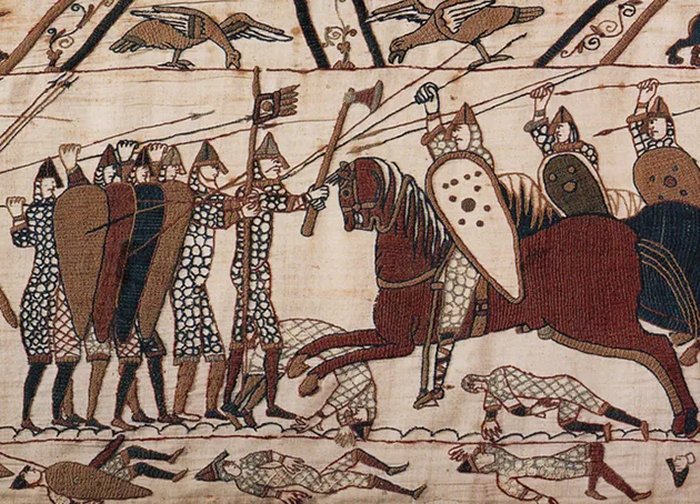
The Normans attacking the Anglo-Saxon shield castle at Hastings in southeast England in October 1066. The battle put Rollo's descendants on the throne of England . Bayeux Tapestry
When researchers opened the tomb, a sarcophagus on the floor of a Fécamp monastery, they discovered Richard the Good’s lower jaw with eight teeth. A DNA analysis is likely to be completed by the autumn and will be presented in cooperation with the French authorities.
Experts can not investigate the remains of Rollo, because his sarcophagus in the Cathedral at Rouen is empty. However, teeth of a close relative are considered excellent genetic and the researchers are optimistic about finding intact DNA.
“Finding teeth is key because DNA can be found there even after this many years. Two forensic experts from Norway and Denmark took five teeth that will now be sent to the University of Oslo and the Centre for GeoGenetics at the University of Copenhagen for analysis,” Ole Bjørn Fausa, the founder of one of the project’s sponsors, the Samlerhuset Group, said.
Fausa said that if Rollo is confirmed to be Ganger Hrólf, it will have great historical significance.
“If the British royal family originates from the northern part of Western Norway, it will change the perception that the Norwegian royal family is relatively young with origins from the British and Danish royal houses,” he said.
Only when the analysis is complete will Danish and Norwegian historians be able to settle their conflicting claims on Rollo.
AncientPages.com
Expand for referencesMore From Ancient Pages
-
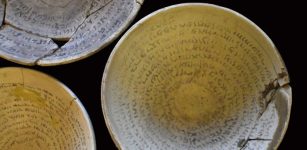 Ancient Magical Bowls Inscribed With Spells And Other Rare Artifacts Seized In Jerusalem Raid
Archaeology | Mar 14, 2022
Ancient Magical Bowls Inscribed With Spells And Other Rare Artifacts Seized In Jerusalem Raid
Archaeology | Mar 14, 2022 -
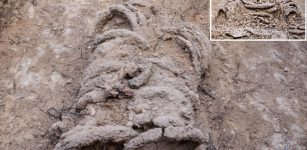 Skeletal Remains Of A 1,500-Year-Old Byzantine Ascetic Monk, Chained In Iron Rings – Uncovered Near Jerusalem
Archaeology | Jan 4, 2023
Skeletal Remains Of A 1,500-Year-Old Byzantine Ascetic Monk, Chained In Iron Rings – Uncovered Near Jerusalem
Archaeology | Jan 4, 2023 -
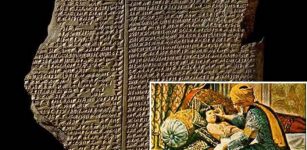 Clay Tablets Reveal Sumerian Doctors Treated Disease With Spells Of Magic And Medicine
Archaeology | Feb 13, 2018
Clay Tablets Reveal Sumerian Doctors Treated Disease With Spells Of Magic And Medicine
Archaeology | Feb 13, 2018 -
 Crop Circles: Are They Cosmic Messages That We Cannot Decipher?
Featured Stories | Mar 26, 2019
Crop Circles: Are They Cosmic Messages That We Cannot Decipher?
Featured Stories | Mar 26, 2019 -
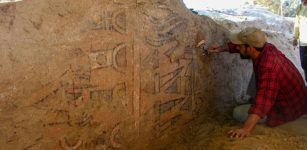 Exceptional Discovery Of Ancient Fresco Depicting Mythological Scenes In Peru
Archaeology | Dec 1, 2022
Exceptional Discovery Of Ancient Fresco Depicting Mythological Scenes In Peru
Archaeology | Dec 1, 2022 -
 Indigenous Village Estimated To Be 11,000 Years Old – Discovered Near Sturgeon Lake
Archaeology | Feb 10, 2025
Indigenous Village Estimated To Be 11,000 Years Old – Discovered Near Sturgeon Lake
Archaeology | Feb 10, 2025 -
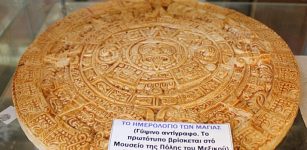 On This Day In History: Mesoamerican Long Count Calendar Begins – On August 11, 3114 B.C
News | Aug 11, 2016
On This Day In History: Mesoamerican Long Count Calendar Begins – On August 11, 3114 B.C
News | Aug 11, 2016 -
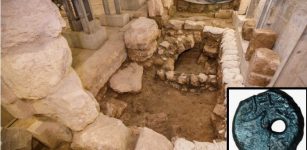 New Evidence Of The Destruction Of The Second Temple In The City Of David
Archaeology | Aug 5, 2023
New Evidence Of The Destruction Of The Second Temple In The City Of David
Archaeology | Aug 5, 2023 -
 Investigation Of The Elusive Will-o’-the-Wisp Leads To A Surprising Discovery
Featured Stories | Feb 6, 2025
Investigation Of The Elusive Will-o’-the-Wisp Leads To A Surprising Discovery
Featured Stories | Feb 6, 2025 -
 Madagascar Hippos Were Forest Dwellers – New Study
Fossils | Jul 8, 2023
Madagascar Hippos Were Forest Dwellers – New Study
Fossils | Jul 8, 2023 -
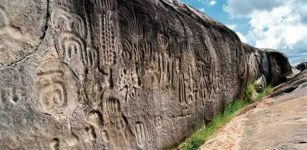 Unsolved Enigma Of The Inga Stone And Its Mysterious Ancient Undeciphered Signs
Artifacts | Jan 18, 2015
Unsolved Enigma Of The Inga Stone And Its Mysterious Ancient Undeciphered Signs
Artifacts | Jan 18, 2015 -
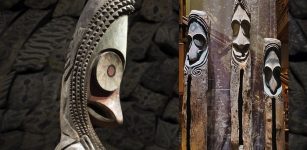 Curious Alien-Looking Slit Gongs Figures From Vanuatu Allowed Villagers To Communicate
Ancient Traditions And Customs | Sep 24, 2018
Curious Alien-Looking Slit Gongs Figures From Vanuatu Allowed Villagers To Communicate
Ancient Traditions And Customs | Sep 24, 2018 -
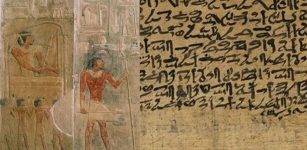 Secrets Of Maxims Of Ptahhotep – Ancient Egyptian Wisdom Is Still Relevant Today
Artifacts | Mar 10, 2018
Secrets Of Maxims Of Ptahhotep – Ancient Egyptian Wisdom Is Still Relevant Today
Artifacts | Mar 10, 2018 -
 Researchers Find An Elusive European Ancestor Of Lager Yeast In Ireland
Archaeology | Dec 14, 2022
Researchers Find An Elusive European Ancestor Of Lager Yeast In Ireland
Archaeology | Dec 14, 2022 -
 Ancient Secrets Of The Nine Unknown Men: Guardians Of Forbidden Knowledge Hidden From Humanity
Ancient Mysteries | Aug 28, 2014
Ancient Secrets Of The Nine Unknown Men: Guardians Of Forbidden Knowledge Hidden From Humanity
Ancient Mysteries | Aug 28, 2014 -
 Unusual Viking Secret Hidden Underground In California Reminds Of A Similar Discovery In Colorado
Featured Stories | Sep 12, 2024
Unusual Viking Secret Hidden Underground In California Reminds Of A Similar Discovery In Colorado
Featured Stories | Sep 12, 2024 -
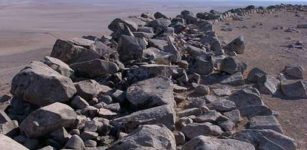 Satellite Images Reveal Huge 4000-Year-Old Military Network In Syria
Archaeology | Dec 23, 2017
Satellite Images Reveal Huge 4000-Year-Old Military Network In Syria
Archaeology | Dec 23, 2017 -
 Burial Of Queen Of Emma Of Normandy Discovered In Winchester Castle
Archaeology | Nov 2, 2021
Burial Of Queen Of Emma Of Normandy Discovered In Winchester Castle
Archaeology | Nov 2, 2021 -
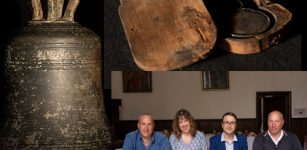 Wreck Of Historic Royal Ship ‘Gloucester’ Discovered Off The English Coast
Archaeology | Jun 10, 2022
Wreck Of Historic Royal Ship ‘Gloucester’ Discovered Off The English Coast
Archaeology | Jun 10, 2022 -
 Viking Treasures Discovered In Chamber Grave In Denmark
Archaeology | Apr 4, 2017
Viking Treasures Discovered In Chamber Grave In Denmark
Archaeology | Apr 4, 2017



